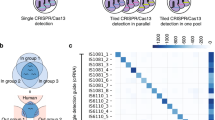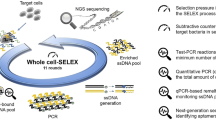Abstract
The study of bacterial populations using whole-genome sequencing is of considerable scientific and clinical interest. However, obtaining bacterial genomic information is not always trivial: the target bacteria may be difficult to culture or uncultured, and they may be found within samples containing complex mixtures of other contaminating microbes and/or host cells, from which it is very difficult to derive robust sequencing data. Here we describe our procedure to generate sufficient DNA for whole-genome sequencing from clinical samples and without the need for culture, as successfully used on the difficult-to-culture, obligate intracellular pathogen Chlamydia trachomatis. Our protocol combines immunomagnetic separation (IMS) for targeted bacterial enrichment with multiple displacement amplification (MDA) for whole-genome amplification (WGA), which is followed by high-throughput sequencing. Compared with other techniques that might be used to generate such data, IMS-MDA is an inexpensive, low-technology and highly transferable process that provides amplified genomic DNA for sequencing from target bacteria in under 5 h, with little hands-on time.
This is a preview of subscription content, access via your institution
Access options
Subscribe to this journal
Receive 12 print issues and online access
$259.00 per year
only $21.58 per issue
Buy this article
- Purchase on Springer Link
- Instant access to full article PDF
Prices may be subject to local taxes which are calculated during checkout

Similar content being viewed by others
References
Mutreja, A. et al. Evidence for several waves of global transmission in the seventh cholera pandemic. Nature 477, 462–465 (2011).
Bryant, J.M. et al. Whole-genome sequencing to identify transmission of Mycobacterium abscessus between patients with cystic fibrosis: a retrospective cohort study. Lancet 381, 1551–1560 (2013).
Harrison, E.M. et al. Whole genome sequencing identifies zoonotic transmission of MRSA isolates with the novel mecA homologue mecC. EMBO Mol. Med. 5, 509–515 (2013).
Croucher, N.J., Harris, S.R., Grad, Y.H. & Hanage, W.P. Bacterial genomes in epidemiology—present and future. Philos. Trans. R. Soc. Lond. B Biol. Sci. 368, 20120202 (2013).
Holden, M.T. et al. A genomic portrait of the emergence, evolution, and global spread of a methicillin-resistant Staphylococcus aureus pandemic. Genome Res. 23, 653–664 (2013).
He, M. et al. Emergence and global spread of epidemic healthcare-associated Clostridium difficile. Nat. Genet. 45, 109–113 (2013).
Eyre, D.W. et al. Detection of mixed infection from bacterial whole genome sequence data allows assessment of its role in Clostridium difficile transmission. PLoS Comput. Biol. 9, e1003059 (2013).
Seth-Smith, H.M.B. et al. Whole-genome sequences of Chlamydia trachomatis directly from clinical samples without culture. Genome Res. 23, 855–866 (2013).
World Health Organization. Prevalence and Incidence of Selected Sexually Transmitted Infections (World Health Organization, Geneva, 2011).
Global WHO alliance for the elimination of blinding trachoma by 2020. in Weekly Epidemiological Report Vol. 17 161–168 (World Health Organisation, Geneva, 2012).
Dean, D. et al. Predicting phenotype and emerging strains among Chlamydia trachomatis infections. Emerg. Infect. Dis. 15, 1385–1394 (2009).
Klint, M. et al. High-resolution genotyping of Chlamydia trachomatis strains by multilocus sequence analysis. J. Clin. Microbiol. 45, 1410–1414 (2007).
Pannekoek, Y. et al. Multi locus sequence typing of Chlamydiales: clonal groupings within the obligate intracellular bacteria Chlamydia trachomatis. BMC Microbiol. 8, 42 (2008).
Pedersen, L.N., Pødenphant, L. & Møller, J.K. Highly discriminative genotyping of Chlamydia trachomatis using omp1 and a set of variable number tandem repeats. Clin. Microbiol. Infect. 14, 644–652 (2008).
Jeffrey, B.M. et al. Genome sequencing of recent clinical Chlamydia trachomatis strains identifies loci associated with tissue tropism and regions of apparent recombination. Infect. Immun. 78, 2544–2553 (2010).
Harris, S.R. et al. Whole-genome analysis of diverse Chlamydia trachomatis strains identifies phylogenetic relationships masked by current clinical typing. Nat. Genet. 44, 364–366 (2012).
Joseph, S.J., Didelot, X., Gandhi, K., Dean, D. & Read, T.D. Interplay of recombination and selection in the genomes of Chlamydia trachomatis. Biol. Direct. 6, 28 (2011).
Andersson, P., Klein, M., Lilliebridge, R.A. & Giffard, P.M. Sequences of multiple bacterial genomes and a Chlamydia trachomatis genotype from direct sequencing of DNA derived from a vaginal swab diagnostic specimen. Clin. Microbiol. Infect. 19, E405–E408 (2013).
Melnikov, A. et al. Hybrid selection for sequencing pathogen genomes from clinical samples. Genome Biol. 12, R73 (2011).
Depledge, D.P. et al. Specific capture and whole-genome sequencing of viruses from clinical samples. PLoS ONE 6, e27805 (2011).
Bos, K.I. et al. A draft genome of Yersinia pestis from victims of the Black Death. Nature 478, 506–510 (2011).
Kent, B.N. et al. Complete bacteriophage transfer in a bacterial endosymbiont (Wolbachia) determined by targeted genome capture. Genome Biol. Evol. 3, 209–218 (2011).
Geniez, S. et al. Targeted genome enrichment for efficient purification of endosymbiont DNA from host DNA. Symbiosis 58, 201–207 (2012).
Lasken, R.S. Genomic sequencing of uncultured microorganisms from single cells. Nat. Rev. Microbiol. 10, 631–640 (2012).
Yilmaz, S. & Singh, A.K. Single cell genome sequencing. Curr. Opin. Biotechnol. 23, 437–443 (2012).
Fitzsimons, M.S. et al. Nearly finished genomes produced using gel microdroplet culturing reveal substantial intraspecies genomic diversity within the human microbiome. Genome Res. 23, 878–888 (2013).
McLean, J.S. et al. Candidate phylum TM6 genome recovered from a hospital sink biofilm provides genomic insights into this uncultivated phylum. Proc. Natl. Acad. Sci. USA 110, E2390–E2399 (2013).
Putman, T.E., Suchland, R.J., Ivanovitch, J.D. & Rockey, D.D. Culture-independent sequence analysis of Chlamydia trachomatis in urogenital specimens identifies regions of recombination and in-patient sequence mutations. Microbiology 159, 2109–2117 (2013).
Skjerve, E., Rørvik, L.M. & Olsvik, O. Detection of Listeria monocytogenes in foods by immunomagnetic separation. Appl. Environ. Microbiol. 56, 3478–3481 (1990).
Niesters, H.G.M., Quint, W.G.V. & Herbrink, P. Antigen capture directed polymerase chain reaction for detection of Chlamydia trachomatis. in Techniques in diagnostic pathology Vol. 2 (eds. Bullock, G., Van Velzen, D. & Warhol, M.J.) (Academic Press, 1991).
Fratamico, P.M., Schultz, F.J. & Buchanan, R.L. Rapid isolation of Escherichia coli O157:H7 from enrichment cultures of foods using an immunomagnetic separation method. Food Microbiol. 9, 105–113 (1992).
Hedrum, A., Lundeberg, J., Påhlson, C. & Uhlén, M. Immunomagnetic recovery of Chlamydia trachomatis from urine with subsequent colorimetric DNA detection. Genome Res. 2, 167–171 (1992).
Dean, F.B., Nelson, J.R., Giesler, T.L. & Lasken, R.S. Rapid amplification of plasmid and phage DNA using Phi29 DNA polymerase and multiply-primed rolling circle amplification. Genome Res. 11, 1095–1099 (2001).
Hosono, S. et al. Unbiased whole-genome amplification directly from clinical samples. Genome Res. 13, 954–964 (2003).
Jalal, H. et al. Development and validation of a rotor-gene real-time PCR assay for detection, identification, and quantification of Chlamydia trachomatis in a single reaction. J. Clin. Microbiol. 44, 206–213 (2006).
Su, H., Watkins, N.G., Zhang, Y.X. & Caldwell, H.D. Chlamydia trachomatis-host cell interactions: role of the chlamydial major outer membrane protein as an adhesin. Infect. Immun. 58, 1017–1025 (1990).
Thornley, M.J. et al. Characterization of a monoclonal antibody to the group antigen of Chlamydia spp. and its use for antigen detection by reverse passive haemagglutination and indirect immunofluorescence. FEMS Microbiol. Lett. 17, 45–49 (1983).
Thornley, M.J., Zamza, S.E., Byrne, M.D., Lusher, M. & Evans, R.T. Properties of monoclonal antibodies to the genus-specific antigen of Chlamydia and their use for antigen detection by reverse passive haemagglutination. J. Gen. Microbiol. 131, 7–15 (1985).
Zong, C., Lu, S., Chapman, A.R. & Xie, X.S. Genome-wide detection of single-nucleotide and copy-number variations of a single human cell. Science 338, 1622–1626 (2012).
Li, R., Li, Y., Kristiansen, K. & Wang, J. SOAP: short oligonucleotide alignment program. Bioinformatics 24, 713–714 (2008).
Li, H. & Durbin, R. Fast and accurate short read alignment with Burrows-Wheeler transform. Bioinformatics 25, 1754–1760 (2009).
Carlson, J.H., Porcella, S.F., McClarty, G. & Caldwell, H.D. Comparative genomic analysis of Chlamydia trachomatis oculotropic and genitotropic strains. Infect. Immun. 73, 6407–6418 (2005).
Thomson, N.R. et al. Chlamydia trachomatis: genome sequence analysis of lymphogranuloma venereum isolates. Genome Res. 18, 161–171 (2008).
Stephens, R.S. et al. Genome sequence of an obligate intracellular pathogen of humans: Chlamydia trachomatis. Science 282, 754–759 (1998).
Unemo, M. et al. The Swedish new variant of Chlamydia trachomatis: Genome sequence, morphology, cell tropism and phenotypic characterization. Microbiology 156, 1394–1404 (2010).
Bankevich, A. et al. SPAdes: a new genome assembly algorithm and its applications to single-cell sequencing. J. Comput. Biol. 19, 455–477 (2012).
Chitsaz, H. et al. Efficient de novo assembly of single-cell bacterial genomes from short-read data sets. Nat. Biotechnol. 29, 915–921 (2011).
Peng, Y., Leung, H.C.M., Yiu, S.M. & Chin, F.Y.L. IDBA-UD: A de novo assembler for single-cell and metagenomic sequencing data with highly uneven depth. Bioinformatics 28, 1420–1428 (2012).
Assefa, S., Keane, T.M., Otto, T.D., Newbold, C. & Berriman, M. ABACAS: algorithm based automatic contiguation of assembled sequences. Bioinformatics 25, 1968–1969 (2009).
Acknowledgements
This work was supported by the Wellcome Trust (grant no. 098051). We thank L. Ellison for useful comments on the manuscript.
Author information
Authors and Affiliations
Contributions
N.R.T., P.M., I.N.C., H.M.B.S.-S. and S.R.H. conceived of the project. H.M.B.S.-S. designed and performed the experiments, researched and optimized the protocol, and wrote the manuscript. N.R.T. supervised the development of the protocol, analyzed the data and wrote the manuscript. S.R.H. performed key data analysis, helped in the development of the protocol and wrote the manuscript. P.S. and S.P. contributed valuable information to the development of the protocol. S.P. provided discarded clinical samples. P.M., M.U., S.P., P.S., I.N.C. and J.P. provided insight into the experimental design and progress of the protocol, and on the results and implications of the work.
Corresponding authors
Ethics declarations
Competing interests
The authors declare no competing financial interests.
Rights and permissions
About this article
Cite this article
Seth-Smith, H., Harris, S., Scott, P. et al. Generating whole bacterial genome sequences of low-abundance species from complex samples with IMS-MDA. Nat Protoc 8, 2404–2412 (2013). https://doi.org/10.1038/nprot.2013.147
Published:
Issue Date:
DOI: https://doi.org/10.1038/nprot.2013.147
This article is cited by
-
Treatment efficacy of azithromycin 1 g single dose versus doxycycline 100 mg twice daily for 7 days for the treatment of rectal chlamydia among men who have sex with men – a double-blind randomised controlled trial protocol
BMC Infectious Diseases (2017)
-
Shotgun metagenomics, from sampling to analysis
Nature Biotechnology (2017)
-
Culture-independent genomic characterisation of Candidatus Chlamydia sanzinia, a novel uncultivated bacterium infecting snakes
BMC Genomics (2016)
-
Capturing the cloud of diversity reveals complexity and heterogeneity of MRSA carriage, infection and transmission
Nature Communications (2015)
-
Whole-genome enrichment and sequencing of Chlamydia trachomatisdirectly from clinical samples
BMC Infectious Diseases (2014)
Comments
By submitting a comment you agree to abide by our Terms and Community Guidelines. If you find something abusive or that does not comply with our terms or guidelines please flag it as inappropriate.



